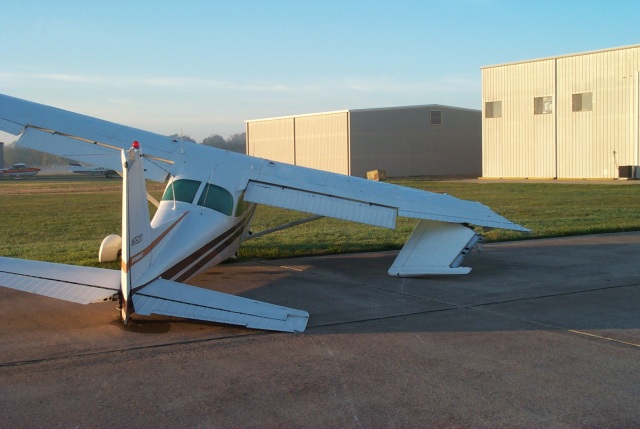Last week, Avweb’s discussion topic was “aircraft recovery parachutes”. There are at least a hundred comments on the subject at http://www.avweb.com/qotw/qotwform.cgi?0047http://www.avweb.com/qotw/qotwform.cgi?0047.
Many of the opinions are predictable negative knee jerks, but some are thoughtful. One thing is clear: in the absence of hard information gained from experience, misinformation is thriving. Pilots without parachtes are busy constructing rationalizations for why the whole idea is nuts.
Last week, Avweb’s discussion topic was “aircraft recovery parachutes”. There are at least a hundred comments on the subject at http://www.avweb.com/qotw/qotwform.cgi?0047http://www.avweb.com/qotw/qotwform.cgi?0047.
Many of the opinions are predictable negative knee jerks, but some are thoughtful. One thing is clear: in the absence of hard information gained from experience, misinformation is thriving. Pilots without parachtes are busy constructing rationalizations for why the whole idea is nuts.
Chutes will be the standard and anyone without will be lacking and struggling to compete…
Last week, Avweb’s discussion topic was “aircraft recovery parachutes”. There are at least a hundred comments on the subject…
That’s interesting. In the latest issue of Aviation consumer (I think) there is an article on the new 2-seat “D4” being certified under the JAR as we speak. It is said to have a BRS.
Maybe the market is speaking. The real determinant will be once they are used the first few times.
Another mid-air. The following is from the AOPA.org web-site. (I’m not sure if the URL will work for non-AOPA members). CAPS is definitely the answer for this kind of incident.

Crippled 172 lands safely after midair
Nov. 30 — A Cessna 172 safely landed at West Houston Airport, Texas, following a midair collision November 26 with a Cessna 150. One-fourth of the 172’s right wing was left hanging down by the impact, and the right main landing gear wheel was knocked off. The aircraft were flying at 2,000 feet in good visibility, National Transportation Safety Board officials told the Houston Chronicle. The pilot of the Cessna 150, 36-year-old Don Lee of Katy, Texas, died after a wing was severed from his aircraft by the impact. His airplane crashed along Interstate 10 just outside of Katy. The pilot of the Cessna 172, Diana Orendorff, spotted the Cessna 150 approaching from behind her left shoulder just before the impact and pulled her aircraft into a climbing right turn. Following impact, her aircraft instantly entered a clockwise spiral dive. Aircraft owner Ed Oppermann then took control, recovering from the dive several hundred feet above the ground, and landed at West Houston on one wheel. The 172 skidded from the runway onto the grass before coming to a stop. Before landing, Oppermann had contacted the airport, declared an emergency, and pinpointed the wreckage location of the Cessna 150 so that rescuers could reach the scene. Neither Orendorff nor Oppermann were injured in the accident, which occurred about 5:15 p.m. local time. Oppermann was able to turn the aircraft only in one direction during the 10-mile flight to West Houston Airport.[View a gallery of additional images.]
The chute will undoubtedly save lives. But don’t underestimate its psychological advantage, too, which can translate to real value. For example, some passengers might feel better knowing it’s there; thus these passengers are happier travelers; thus so is the pilot happier . . . and less tense . . . and more effective.
A chute would give me the confidence, as a pilot, to fly “direct to” as if I were flying a twin or a turbine. Again, a “mere” psychological comfort shows up as real time saved in the air.
Last week, Avweb’s discussion topic was “aircraft recovery parachutes”. There are at least a hundred comments on the subject at http://www.avweb.com/qotw/qotwform.cgi?0047http://www.avweb.com/qotw/qotwform.cgi?0047.
Many of the opinions are predictable negative knee jerks, but some are thoughtful. One thing is clear: in the absence of hard information gained from experience, misinformation is thriving. Pilots without parachtes are busy constructing rationalizations for why the whole idea is nuts.
The overwhelming cause of fatal accidents is flight into IMC. To this end, I believe the most important safety feature in one’s airplane is the autopilot. Having something like a S-TEC 55, means you have a very capable co-pilot when the chips are down and you are low and slow in unfamiliar ground. Especially with a vacuum failure. Assuming you have that in your panel – then the one other redressable hazard is an engine-out over bad terrain. Enter the parachute. As far as engine out on take-off… just hope you’ve planned for and have an immediate landing point (the best reason to overfly any new airport before you land – to find those places!)
Give me a good AP, and a chute, and perhaps an all-electric SR-22 and I bet you’ll see a lot more people flying in the next 20 years.
One caveat – those pictures of the 172 with half-a-wing show there are times when you don’t need to pull the chute and might be tempted. I’ll be interested to see how the thinking of when to pull the chute evolves.
